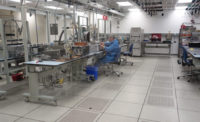Smart factories have become a must in the aerospace and defense industries. In a recent Deloitte study, 86 percent of manufacturers think smart factory initiatives will be the main driver of competitiveness within five years.
A key part of this movement will be manufacturing execution systems (MES), defined as an all-inclusive, dynamic software system for managing and tracking data and documents throughout the manufacturing process, from raw materials to final product. MES is a functional layer between enterprise resource planning (ERP) software and a process control system, so the data gathered will be critical for helping manufacturers become more efficient and bolster production.
For most aerospace and defense manufacturers, MES is not new. However, many have separate MES systems across their factory floors, so data on product tracking, ordering and management is often disjointed. With a centralized MES, aerospace and defense manufacturers will gain real-time information from across their factories to give managers the data they need to make decisions that can help to reduce costs, increase efficiency and quality, and power new capabilities.
Aerospace and Defense 4.0
In 2020, IFS conducted research into the Industry 4.0 maturity curve in the aerospace and defense industries, with surprising results. The polling results from a webinar attended by aerospace and defense manufacturers found that only 12 percent of nearly 150 attendees had not made Industry 4.0 an enterprise-wide priority, while the majority of the remaining manufacturing companies (68 percent) were still researching how these technological advances could help achieve their digital transformation goals.
While the interest in Industry 4.0 technologies was clear to see, the aerospace and defense market was still at the beginning of the adoption journey. Bridging the chasm from interest to adoption was going to rely on positive results from early adopters prospering from deploying the latest technology.
Things have since taken off. The widespread emergence of Industry 4.0 technologies is here and now and their implementation on flexible enterprise software platforms is helping unlock previously inaccessible financial, operational and security benefits for aerospace and defense manufacturers.
Enlisting powerful MES software is now prerequisite to reaping the benefits of Industry 4.0 and has a hugely positive impact on production rate and execution, quality control, and overall equipment effectiveness (OEE).
MES transforms inventory, production and quality control activities to deliver efficient and compliant work execution by digitally tracking and documenting the end-to-end manufacturing process. These systems digitally capture each step of the transformation of raw materials into finished goods for documenting compliance, data-driven continuous improvement, and supply chain transparency in real time.
MES is a key part of the “vertical integration” of manufacturing by ensuring data is accessible from the shop floor to the top floor, continuously fed to real-time dashboards, and enabling control at every level of the manufacturing organization. From the shop floor supervisor, to the director of operations, to the quality manager, and even the C-Suite, everyone in the chain has real-time information for actionable intelligence.
For aerospace and defense manufacturers, the devil is in the details, and MES must be able to provide the right data. Unlike traditional discrete manufacturing of parts and assemblies, aerospace and defense equipment is held to a higher standard of accuracy and safety. Engineering tolerances for aircraft can be down to the thousandths of an inch, and this could just be on an exterior panel! Governing bodies, such as the Federal Aviation Administration have set regulations and standards that aerospace and defense products must meet. Failure to abide by these regulations could have serious consequences including financial penalties or, more importantly, the safety of pilots, crew and passengers. Despite the help MES can provide manufacturers in meeting these tight tolerances and regulations, only 30 percent of manufacturers have started implementing smart factory initiatives.
The Pitfalls of Integrating MES Data
Running MES software as part of a core manufacturing system offers significant benefits. However, operating separate MES systems is not conducive to providing the level of vertical reporting required in a modern manufacturing environment. Manufacturers often end up with multiple MES systems because existing systems are unable to provide the level of granularity and specificity necessary to operate in the aerospace and defense manufacturing sector.
As a result, manufacturers end up with heavily customized software for specific applications. Managing these disparate systems is time-consuming and risks isolating data that would otherwise be critical to managing overall production and quality.
It’s the MES that tracks the daily operation of your shop floor. Software with built-in MES functionality provides the essential digital backbone between the proliferation of smart devices and machines and core manufacturing planning software, seamlessly integrating this technology with the higher-level software used to plan production. In this way, open interoperable MES systems enable full traceability of parts, components, and projects—from design right through to production.
As a prerequisite, MES software should enable CAD integration; robust, real-time data collection; and more sophisticated integrations through IoT and so-called “RESTful APIs,” as just a few examples. A RESTful API is an interface that two computer systems use to exchange information securely over the internet. Most business applications have to communicate with other internal and third-party applications to perform various tasks. For example, to generate monthly pay slips, an internal accounts system must share data with the company’s banking system to automate invoicing and communicate with an internal timesheet application. RESTful APIs support this information exchange because they follow secure, reliable and efficient software communication standards.
An MES system also needs to support dispatching and shop floor operation; improved production management and tracking; and quality management processes. Then there’s the need to enable machine monitoring and reporting of key performance indicators.
Instead of implementing a different MES for each manufacturing operation and then tying them all together with other manufacturing software, an MES should be part of one overarching software package that’s fully integrated and connected right out of the box.
Better Contract Management
Another pain point for aerospace and defense manufacturers, in particular, is working in the strict regulatory ecosystem associated with the supply chain for the U.S. Department of Defense. The DOD’s stringent reporting requirements are difficult to manage manually.
All defense assets, equipment and services built in the U.S. for internal and external use, right down to individual parts for an F-35, are all subject to severe supplier classification tracking, reporting standards, and compliance. Recent polling results from an IFS and Aviation Week webinar underscored the top pressure points for aerospace and defense manufacturers. More than one-third of respondents (37 percent) cited that industry complexity comes from compliance challenges, such as stringent import, export and security regulations.
Here, the benefits of an all-in-one MES and ERP system are huge. A shipping order, for example, would automatically go back to the ERP and then to the defense contract management module for reporting and payment. Job done!
Within defense contract management, this streamlined approach between different operational areas of the business means aerospace and defense manufacturers can get automated reports done faster and more accurately—and, ultimately, receive faster payment.
Human Capital Gains
Aerospace and defense manufacturing, like many other industries, is experiencing a skilled labor shortage. According to news website Future Aviation Aerospace Workforce, the aerospace and defense manufacturing industry will need 3.5 million workers just for by 2026. A connected MES-ERP system can bring human capital benefits.
By improving processes with better feedback on MES data, aerospace and defense manufacturers can upskill employees for higher level work while the factory is automated. It’s a win-win from a change management perspective, as it’s easier to sell a process improvement rather than introducing an army of robots onto the factory floor.
This upskilling approach is reflected by McKinsey research that highlights: “As the aerospace and defense industry evolves, re-skilling will be central to positioning the workforce to accommodate this evolution. Respondents indicated that the top three areas of investment in re-skilling are leadership (55 percent), engineering skills (45 percent) and cybersecurity (42 percent).”
The Path to Aerospace and Defense 4.0
Getting MES right is a critical component of aerospace and defense 4.0—particularly given the unique requirements of the aerospace and defense industry. MES has been around for some time, but its capabilities have grown and evolved. It has had to keep up with new and emerging trends, just like the rest of the aerospace and defense manufacturing software stack does, and that includes connection to lower-level equipment and the ability to export data for analysis and decision making.
For MES to improve production, quality and KPIs, it cannot sit in isolation from other manufacturing systems. MES must be an embedded part of a wider system to enable aerospace and defense manufacturers to unlock the benefits of Industry 4.0 and vertical integration of manufacturing.
ASSEMBLY ONLINE
For more information on MES software, visit www.assemblymag.com to read these articles:
MES Software Helps Manufacturer of Revolutionary Hearing Aid



